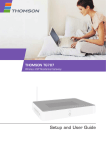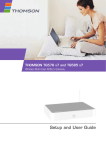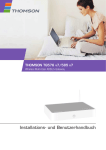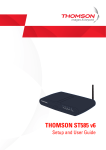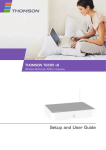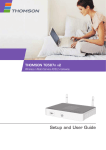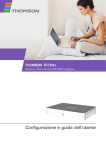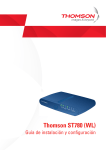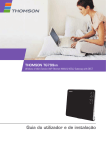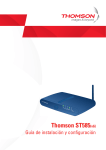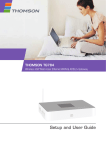Download Technicolor - Thomson 585 v7 Network Router User Manual
Transcript
Thomson TG576 v7/585 v7 Wireless Multi-User ADSL2+ Gateway Setup and User Guide Thomson TG576 v7/ 585 v7 Setup and User Guide Copyright Copyright ©1999-2008 Thomson. All rights reserved. Distribution and copying of this document, use and communication of its contents is not permitted without written authorization from Thomson. The content of this document is furnished for informational use only, may be subject to change without notice, and should not be construed as a commitment by Thomson. Thomson assumes no responsibility or liability for any errors or inaccuracies that may appear in this document. Thomson Telecom Belgium Prins Boudewijnlaan, 47 B-2650 Edegem Belgium http://www.thomson-broadband.com Trademarks The following trademarks may be used in this document: > > > > DECT is a trademark of ETSI. > > UPnP™ is a certification mark of the UPnP™ Implementers Corporation. > Apple® and Mac OS® are registered trademarks of Apple Computer, Incorporated, registered in the United States and other countries. > > UNIX® is a registered trademark of UNIX System Laboratories, Incorporated. Bluetooth® word mark and logos are owned by the Bluetooth SIG, Inc. Ethernet™ is a trademark of Xerox Corporation. Wi-Fi® and the Wi-Fi logo are registered trademarks of the Wi-Fi Alliance. "Wi-Fi CERTIFIED", "Wi-Fi ZONE", "Wi-Fi Alliance", their respective logos and "Wi-Fi Protected Access" are trademarks of the Wi-Fi Alliance. Microsoft®, MS-DOS®, Windows®, Windows NT® and Windows Vista® are either registered trademarks or trademarks of Microsoft Corporation in the United States and/or other countries. Adobe®, the Adobe logo, Acrobat and Acrobat Reader are trademarks or registered trademarks of Adobe Systems, Incorporated, registered in the United States and/or other countries. Other brands and product names may be trademarks or registered trademarks of their respective holders. Document Information Status: v1.0 (February 2008) Reference: E-DOC-CTC-20080118-0003 Short Title: Setup and User Guide TG576 v7/585 v7 R8.1 (en) Contents About this Setup and User Guide ............................................. 1 1 Installation.................................................................................... 3 1.1 Preliminary Steps ............................................................................................ 4 1.2 Placing your Thomson Gateway ..................................................................... 5 1.3 Installing your Thomson Gateway .................................................................. 6 1.3.1 Guided Installation ................................................................................................................................. 7 1.3.2 Manual Installation ................................................................................................................................. 9 2 Thomson Gateway Basics ........................................................ 11 2.1 Thomson Gateway LED Behaviour ................................................................ 12 2.2 Thomson Gateway Web Interface ................................................................. 14 2.3 Backing Up/Restoring your Configuration .................................................... 17 3 Adding New Devices to your Network.................................... 19 3.1 Adding a Computer to your Network............................................................ 20 3.1.1 Connecting a computer using Wireless.............................................................................................. 21 3.1.2 Connecting a computer using Ethernet .............................................................................................. 22 4 Getting the Most Out of Your Thomson Gateway................. 23 4.1 Universal Plug and Play ................................................................................ 24 4.1.1 Accessing Your Thomson Gateway with UPnP ................................................................................. 25 4.1.2 Managing your Internet connection with UPnP................................................................................. 26 4.1.3 Configuring UPnP on the Thomson Gateway .................................................................................... 28 4.1.4 Installing UPnP on Windows XP ......................................................................................................... 29 4.2 Assigning a service (HTTP, FTP,...) to a computer ........................................ 31 4.3 Dynamic DNS ................................................................................................ 33 5 Wireless Security ....................................................................... 35 5.1 Encryption ..................................................................................................... 36 5.1.1 Configuring WEP Encryption ............................................................................................................... 37 5.1.2 Configuring WPA-PSK Encryption ...................................................................................................... 38 5.2 Access Control .............................................................................................. 39 5.3 Disabling SSID Broadcast ............................................................................. 42 E-DOC-CTC-20080118-0003 v1.0 i Contents ii 6 Internet Security ........................................................................ 43 6.1 Firewall.......................................................................................................... 44 6.2 Web site Filtering .......................................................................................... 45 6.2.1 Denying access to a specific Web site ................................................................................................ 46 6.2.2 Allowing access to a specific Web site ............................................................................................... 47 6.2.3 Redirecting a Web site ......................................................................................................................... 48 6.2.4 Redirecting all Web sites ..................................................................................................................... 49 7 Troubleshooting ........................................................................ 51 7.1 Setup wizard Troubleshooting ...................................................................... 52 7.2 General Thomson Gateway Troubleshooting ................................................ 53 7.2.1 Wired Connection Troubleshooting.................................................................................................... 54 7.2.2 Wireless Connection Troubleshooting ............................................................................................... 55 7.3 Reset to Factory Defaults ............................................................................. 56 E-DOC-CTC-20080118-0003 v1.0 About this Setup and User Guide About this Setup and User Guide Used Symbols A note provides additional information about a topic. A caution warns you about potential problems or specific precautions that need to be taken. Terminology Generally, the Thomson TG576 v7/585 v7 will be referred to as Thomson Gateway in this Setup and User Guide. Typographical Conventions Following typographical convention is used throughout this manual: Sample text indicates a hyperlink to a Web site. Example: For more information, visit us at www.thomson-broadband.com. Sample text indicates an internal cross-reference. Example: If you want to know more about guide, see “1 Introduction” on page 7”. Sample text indicates an important content-related word. Example: To enter the network, you must authenticate yourself. Sample text indicates a GUI element (commands on menus and buttons, dialog box elements, file names, paths and folders). Example: On the File menu, click Open to open a file. Documentation and software updates Thomson continuously develops new solutions, but is also committed to improving its existing products. For more information on Thomson's latest technological innovations, documents and software releases, visit us at http://www.thomson-broadband.com. E-DOC-CTC-20080118-0003 v1.0 1 About this Setup and User Guide 2 E-DOC-CTC-20080118-0003 v1.0 1 Installation 1 Installation Introduction In a few minutes you will be able to access the Internet using your Thomson Gateway. This Setup and User Guide will show you how to set up your Thomson Gateway and how to connect your computer(s) to the Internet. E-DOC-CTC-20080118-0003 v1.0 3 1 Installation 1.1 Preliminary Steps DSL service The DSL service must be up and running on your telephone line. If both conventional telephone and DSL service are simultaneously available from the same copper pair, you will need a central splitter or distributed filters for decoupling DSL and telephone signals. Public telephone lines carry voltages that can cause electric shock. Only try to set up splitter/ filters that have been designed to be installed by unqualified personnel. For further assistance, contact your Internet Service Provider. Computer requirements To connect a computer via Ethernet, make sure the computer is equipped with an Ethernet Network Interface Card (NIC). For wireless networking, you will need a WiFi-certified wireless client adapter for each computer you want to connect wirelessly. Internet connection details You may need the following connection details from your Internet Service Provider (ISP): Your ISP’s method for connecting to the Internet (for example PPPoE) The VPI/VCI (for example 8/35) Your user name and password to connect to the Internet for PPP connections Your IP settings in case of static configurations Optionally your ISP may indicate the Service Profile to use during Setup. You may have received this information when you subscribed to DSL at your Internet Service Provider (ISP). You will be prompted for this information at a given step in the installation procedure. Voice over IP (VoIP) connection details If you want to be able to make phone calls over the Internet, you will need following details for your VoIP connection: A user account at your VoIP Service Provider The server settings of your VoIP Service These settings may be provided by your Internet Service Provider. 4 E-DOC-CTC-20080118-0003 v1.0 1 Installation 1.2 Placing your Thomson Gateway Possibilities You can mount the Thomson Gateway on a wall or simply place it on a desk. Wall mount Proceed as follows to mount the Thomson Gateway on a wall or other vertical surface: 1 Take the wall mount leaflet out of the box. 2 Stick the wall mount leaflet on the place where your want to mount your Thomson Gateway. 3 Drill two holes through the marked positions. 4 Fasten two screws in the wall holes. The screws should protrude five millimetres from the surface of the wall. 5 Attach your Thomson Gateway on the wall using the two mounting slots on the bottom. If you install the Thomson Gateway onto plasterboard, use dowels to secure the screws. Otherwise the strain of the cables connected to the Thomson Gateway rear panel connectors could pull the Thomson Gateway from the wall. E-DOC-CTC-20080118-0003 v1.0 5 1 Installation 1.3 Installing your Thomson Gateway Installation methods There two ways to set up your Thomson Gateway: Guided Installation Manual Installation Guided Installation How it works The Setup wizard included on the CD will guide you through all configuration aspects of your Thomson Gateway. This is the recommended way to install your Thomson Gateway. Requirements Your computer must run one of the following operating systems: Microsoft Windows Vista (x64) Microsoft Windows XP Service Pack (SP) 2 or higher Microsoft Windows XP x64 SP 1 or higher Microsoft Windows 2000 SP4 Mac OS X 10.3 (Panther) Mac OS X 10.4 (Tiger) You must have administrative rights on your computer Getting started Proceed with“1.3.1 Guided Installation” on page 7. Manual Installation How it works The Setup and User Guide will first help you to connect your computer to the Thomson Gateway. After this is done, you can configure your Thomson Gateway using your web browser. Requirements Javascript must be enabled on your web browser. Getting started Proceed with“1.3.2 Manual Installation” on page 9. 6 E-DOC-CTC-20080118-0003 v1.0 1 Installation 1.3.1 Guided Installation Connecting devices: wait! Do not plug in any cables or connect any devices until you are prompted to do so by the wizard. In case of problems If you encounter problems during this installation please refer to “7.1 Setup wizard Troubleshooting” on page 52. Starting the wizard To start the wizard: 1 Insert the Setup CD into your computer's CD- or DVD-ROM drive. 2 If your computer runs: Microsoft Windows: The CD should autostart. Mac OS X: Double-click Menu in the window with the content of the CD. 3 Select the language of your choice and click OK. 4 The Setup wizard will now guide you through the installation. 5 At the end of the installation, following screen appears: 6 Select the Go to the Thomson Gateway Web Interface if you want to go to the Thomson Gateway Web Interface after closing the wizard. On the Thomson Gateway Web Interface, you can further configure your Thomson Gateway. 7 Click Finish. 8 The CD menu appears. E-DOC-CTC-20080118-0003 v1.0 7 1 Installation CD menu On the CD Menu, click: (Re)configure my Thomson Gateway to reconfigure your Thomson Gateway or add a new computer to your network. View Documentation to view the documentation that is available for your Thomson Gateway. This list will be automatically updated if you are connected to the Internet. Visit Thomson Broadband to visit the online support sections on www.thomson-broadband.com. Actual available items may depend on the Setup CD delivered with your Thomson Gateway. 8 E-DOC-CTC-20080118-0003 v1.0 1 Installation 1.3.2 Manual Installation Procedure Proceed as follows: 1 Connect the cables 2 Configure the Thomson Gateway Connect the cables Proceed as follows: 1 Connect your computer to the Thomson Gateway as described in “3.1 Adding a Computer to your Network” on page 20. 2 Connect the Thomson Gateway to the DSL line. 3 Connect the power supply. 4 Turn on the Thomson Gateway. Configure the Thomson Gateway 1 Open your web browser. 2 The Thomson Gateway informs you that you have not yet configured your Thomson Gateway. If this window does not appear browse to http://dsldevice.lan or to the IP address of your Thomson Gateway (by default: 192.168.1.254) and click Thomson Gateway on the menu on the left-hand side. 3 Click Setup my Thomson Gateway. 4 The Easy Setup wizard appears. This wizard will guide you through the configuration of your Thomson Gateway. Click Next and follow the instructions. E-DOC-CTC-20080118-0003 v1.0 9 1 Installation 10 E-DOC-CTC-20080118-0003 v1.0 2 Thomson Gateway Basics 2 Thomson Gateway Basics In this chapter Topic Page Thomson Gateway LED Behaviour 12 Thomson Gateway Web Interface 14 Backing Up/Restoring your Configuration 17 E-DOC-CTC-20080118-0003 v1.0 11 2 Thomson Gateway Basics 2.1 Thomson Gateway LED Behaviour Status LEDs On the top panel of your Thomson Gateway, you can find a number of status LEDs, indicating the state of the device during normal operation. The following table shows the meaning of the different LEDs. Indicator Description Name Colour State Power Green Solid on Power on, normal operation Red Solid on Power on, self-test failed, indicating device malfunction Orange Solid on Bootloader active (during upgrade) Off Ethernet Green Power off Blinking Ethernet activity Solid on Ethernet connection, no activity Off Wireless Green Amber Red Red/green No Ethernet connection Blinking Wireless activity, WPA(2) encryption Solid on No wireless activity, WPA(2) encryption Blinking Wireless activity, WEP encryption Solid on No wireless activity, WEP encryption Blinking Wireless activity, no security Solid on No wireless activity, no security Toggling Wireless client registration phase Off Broadband Green WLAN disabled Blinking Pending DSL line synchronisation Solid on DSL line synchronised Off Internet Green Red Off 12 No DSL line Blinking Internet activity Solid on Internet connectivity, no activity Solid on Internet connection setup failed No Internet connection E-DOC-CTC-20080118-0003 v1.0 2 Thomson Gateway Basics Ethernet LED A LED may be provided per Ethernet port to indicate link integrity (or activity). LED Status Description Off No connection on this port Solid on Ethernet link up Blinking Data is flowing from/to this port E-DOC-CTC-20080118-0003 v1.0 13 2 Thomson Gateway Basics 2.2 Thomson Gateway Web Interface Introduction The Thomson Gateway Web Interface allows you to configure your Thomson Gateway using your web browser. Requirements Javascript must be enabled on your browser. Accessing the Thomson Gateway Web Interface Proceed as follows: 1 Open your web browser. 2 Browse to http://dsldevice.lan or to the IP address of your Thomson Gateway (by default: 192.168.1.254). 3 If you have protected your Thomson Gateway with a user name and password, the Thomson Gateway will prompt you to enter these. Enter your user name and password and click OK. 4 The Thomson Gateway Web Interface appears. If your computer runs Windows Vista or Windows XP, you can also access the Thomson Gateway Web Interface using the Internet Gateway Device icon. For more information, see “4.1 Universal Plug and Play” on page 24. 14 E-DOC-CTC-20080118-0003 v1.0 2 Thomson Gateway Basics Components 2 3 4 1 5 6 Label Description 1 Menu 2 Language Bar 3 Navigation Bar 4 Notification Area 5 Content pane 6 Tasks Menu The menu is located on the left side of the page and consists of the following menu items: Thomson Gateway: Provides basic information on the Thomson Gateway. Broadband Connection: Allows you to view/configure your broadband connections. Toolbox: Allows you to assign games or applications to a device and secure your Internet connection. Home Network: Allows you to manage your local network. Language Bar The language bar is located in the top banner and allows you to change the language of the Thomson Gateway Web interface. The language bar will only be shown if more than one language is available. E-DOC-CTC-20080118-0003 v1.0 15 2 Thomson Gateway Basics Navigation Bar The navigation bar is located at the top of the page and allows you to: View the current user name. Click this name to change your password or switch to another user. View the current position on the Thomson Gateway Web interface. Select change the display level of the page (for example: Overview, Details or Configure) Get context-related Help information. Notification Area The notification area is located under the Navigation Bar and is used to display: Error messages, indicated by a red traffic light. Warnings, indicated by an orange traffic light. Information, indicated by a green traffic light. If none of these events occur, the notification area will not be shown. Content pane The content pane is located at the centre of the page and displays the information and configurable items of the selected topic. Tasks To allow a quick configuration of your Thomson Gateway, some pages may offer you a number of related tasks in the Pick a task list. These tasks will guide you to the page where you can perform the selected task. 16 E-DOC-CTC-20080118-0003 v1.0 2 Thomson Gateway Basics 2.3 Backing Up/Restoring your Configuration Introduction Once you have configured your Thomson Gateway to your needs, it may be a good idea to save your configuration for later use. This way you can always return to your working configuration in case of problems. Backing up your configuration Proceed as follows: 1 Browse to the Thomson Gateway Web Interface. 2 On the Thomson Gateway menu, click Configuration. 3 In the Pick a task list, click Save or Restore Configuration. 4 Under Backup current configuration, click Backup Configuration Now. 5 The Thomson Gateway prompts you to save your file. 6 Save your file to a location of your choice. Restoring your configuration Proceed as follows: 1 Browse to the Thomson Gateway Web Interface. 2 On the Thomson Gateway menu, click Configuration. 3 In the Pick a task list, click Save or Restore Configuration. 4 Under Restore saved configuration, click Browse. 5 Open your backup file. 6 The Thomson Gateway restores your configuration. E-DOC-CTC-20080118-0003 v1.0 17 2 Thomson Gateway Basics 18 E-DOC-CTC-20080118-0003 v1.0 3 Adding New Devices to your Network 3 Adding New Devices to your Network In this chapter Topic Adding a Computer to your Network E-DOC-CTC-20080118-0003 v1.0 Page 20 19 3 Adding New Devices to your Network 3.1 Adding a Computer to your Network Guided Installation If you configured your Thomson Gateway using the Guided Installation, use the same procedure on the computer that you want to add. At a specific point in the installation, the Setup wizard will inform you that the Thomson Gateway has already been configured: Select No and click Next to continue. Manual Installation You can also manually add a new computer to your local network: 20 Connecting a computer using Wireless Connecting a computer using Ethernet E-DOC-CTC-20080118-0003 v1.0 3 Adding New Devices to your Network 3.1.1 Connecting a computer using Wireless Before you start Before you can connect a computer to your wireless network you need to know which Network Name (SSID) and encryption your Thomson Gateway is using. Where can I find the SSID? If you did not change the SSID manually, your Thomson Gateway uses the SSID that is printed on the bottom panel label of your Thomson Gateway. Where can I find the encryption? You have not yet configured your Thomson Gateway In this case, no encryption is used. You have already configured your Thomson Gateway using the Guided Installation If you choose to use the wireless settings proposed by the Setup wizard, you can find the encryption keys on the label on the bottom of your Thomson Gateway: Forgot your wireless settings? If you have changed the wireless settings manually and you can’t remember your settings, try one of the following: If one of your computers is already connected to your network: 1 Browse to the Thomson Gateway Web Interface on a computer that is already connected to your network. 2 On the Home Network menu, click Wireless. 3 In the upper-right corner, click Details. 4 The wireless Access Point page appears. Under: Configuration, you can find the network name (SSID). Security, you can find the encryption. If none of your computers is connected to your network, connect a computer using a wired connection and follow the procedure above to find out what your wireless settings are. Another option is to reset your Thomson Gateway and reconfigure it all over again. For more information, see “7.3 Reset to Factory Defaults” on page 56. Procedure Proceed as follows: 1 Configure your computer with the same wireless settings as your Thomson Gateway. For more information, consult the help of your wireless client. 2 If you enabled the access control list on the Thomson Gateway, you have to register your computer before you can connect to the network. Access control is disabled by default. For more information, see “5.2 Access Control” on page 39. E-DOC-CTC-20080118-0003 v1.0 21 3 Adding New Devices to your Network 3.1.2 Connecting a computer using Ethernet Requirements Your computer must have a free Ethernet port. Your computer must be configured to obtain an IP address automatically. This is the default setting. Procedure Proceed as follows: 22 1 Connect one end of the (yellow) Ethernet cable to (one of the) yellow Ethernet port(s) of your Thomson Gateway: 2 Connect the other end of the (yellow) Ethernet cable to your computer. 3 Your computer is now connected to your network. No additional configuration is needed. E-DOC-CTC-20080118-0003 v1.0 4 Getting the Most Out of Your Thomson Gateway 4 Getting the Most Out of Your Thomson Gateway In this chapter In this chapter we will take a closer look at following features: Topic Page Universal Plug and Play 24 Assigning a service (HTTP, FTP,...) to a computer 31 Dynamic DNS 33 Feature availability Depending on the configuration offered by your Internet Service Provider (ISP), some features may not be available on your Thomson Gateway. For more information, contact your ISP. E-DOC-CTC-20080118-0003 v1.0 23 4 Getting the Most Out of Your Thomson Gateway 4.1 Universal Plug and Play Introduction UPnP is designed to automate the installation and configuration of a (small) network as much as possible. This means that UPnP-capable devices can join and leave a network without any effort of a network administrator. Supported Operating Systems Following operating systems support UPnP: Windows Vista Windows XP If your computer is running Windows XP, you first have to install the UPnP component. For more information, see “4.1.4 Installing UPnP on Windows XP” on page 29. UPnP and the Thomson Gateway With UPnP you can: 24 Access the Thomson Gateway Web Interface without having to open the Thomson Gateway Web Interface. For more information, see Accessing Your Thomson Gateway with UPnP. Connect/disconnect without having to open the Thomson Gateway Web Interface. For more information, see Managing your Internet connection with UPnP. Automatic port configuration for UPnP-enabled games and applications. You do not have to create port to run services on a computer. If the application is UPnP-enabled, UPnP will create these entries automatically. For more information, see Assigning a service (HTTP, FTP,...) to a computer. E-DOC-CTC-20080118-0003 v1.0 4 Getting the Most Out of Your Thomson Gateway 4.1.1 Accessing Your Thomson Gateway with UPnP Windows Vista If you computer runs Windows Vista: 1 On the Windows Start menu, click Network. 2 The Network window appears: 3 Right-click your Thomson Gateway (displayed as Thomson TGXXX) and click View device web page. 4 The Thomson Gateway Web Interface appears. Windows XP If you computer runs Windows XP: 1 Go to My Network Places. 2 The My Network Places window appears: 3 Double-click your Thomson Gateway (displayed as Thomson TGXXX). 4 The Thomson Gateway Web Interface appears. E-DOC-CTC-20080118-0003 v1.0 25 4 Getting the Most Out of Your Thomson Gateway 4.1.2 Managing your Internet connection with UPnP Windows Vista If you computer runs Windows Vista: 1 On the Windows Start menu, click Network. 2 The Network window appears: 3 Right-click your Thomson Gateway (displayed as Thomson TGXXX). 4 If you are currently: Connected to the Internet, click Disable to disconnect from the Internet. Not connected to the Internet, click Enable to connect to the Internet. Windows XP Proceed as follows: 26 1 On the Windows Start menu, click (Settings >) Control Panel. 2 The Control Panel window appears. Click (Network and Internet Connections) > Internet Connections. 3 The Network Connections window appears; 4 If you right-click the Internet Connection icon, you can connect/disconnect your connection to the Internet. E-DOC-CTC-20080118-0003 v1.0 4 Getting the Most Out of Your Thomson Gateway Disabling this feature To prevent that users can connect/disconnect you can enable Extended Security. For more information, see “4.1.3 Configuring UPnP on the Thomson Gateway” on page 28. E-DOC-CTC-20080118-0003 v1.0 27 4 Getting the Most Out of Your Thomson Gateway 4.1.3 Configuring UPnP on the Thomson Gateway Introduction On the Thomson Gateway Web Interface you can: Enable/Disable UPnP Extended Security Enable/Disable UPnP Proceed as follows: 1 Browse to the Thomson Gateway Web Interface. 2 On the Toolbox menu, click Game & Application Sharing. 3 Under Universal Plug and Play: Select the Use UPnP check box, to enable UPnP. Clear the Use UPnP check box, to disable UPnP. 4 Click Apply. Extended Security If Extended Security is enable only limited UPnP operation between the host and the Thomson Gateway is allowed. A local host is not allowed to connect/disconnect the Thomson Gateway Internet connection. You can then only connect/disconnect the Internet connection on the Thomson Gateway Web Interface. Enabling Extended Security Proceed as follows: 28 1 Browse to the Thomson Gateway Web Interface. 2 On the Toolbox menu, click Game & Application Sharing. 3 Under Universal Plug and Play, select Use Extended Security. 4 Click Apply. E-DOC-CTC-20080118-0003 v1.0 4 Getting the Most Out of Your Thomson Gateway 4.1.4 Installing UPnP on Windows XP Adding UPnP If you are running Microsoft Windows XP, it is recommended to add the UPnP component to your system. Proceed as follows: 1 In the Start menu, click (Settings >) Control Panel. 2 The Control Panel window appears. Click Add or Remove Programs. 3 The Add or Remove Programs window appears. Click Add/Remove Windows Components. 4 The Windows Components Wizard appears: In the Components list, select Networking Services and click Details 5 The Networking Services window appears: Select Universal Plug and Play or UPnP User Interface and click OK. 6 Click Next to start the installation and follow the instructions in the Windows Components Wizard. 7 At the end of the procedure the Wizard informs you that the installation was successful. Click Finish to quit. E-DOC-CTC-20080118-0003 v1.0 29 4 Getting the Most Out of Your Thomson Gateway Adding IGD Discovery and Control Your Windows XP system is able to discover and control Internet Gateway Devices (IGD), like the Thomson Gateway on your local network. Therefore, it is recommended to add the IGD Discovery and Control client to your system. Proceed as follows: 1 On the Windows taskbar, click Start. 2 Select (Settings >) Control Panel > Add or Remove Programs. 3 In the Add or Remove Programs window, click Add/Remove Windows Components. 4 The Windows Components Wizard appears: Select Networking Services in the Components list and click Details. 5 The Networking Services window appears: Select Internet Gateway Device Discovery and Control Client and click OK. 30 6 Click Next to start the installation and follow the instructions in the Windows Components Wizard. 7 At the end of the procedure, the Wizard informs you that the installation was successful. Click Finish to quit. E-DOC-CTC-20080118-0003 v1.0 4 Getting the Most Out of Your Thomson Gateway 4.2 Assigning a service (HTTP, FTP,...) to a computer Introduction The Thomson Gateway allows you to use one internet connection for multiple computers. This means that all your computers share one public IP address, as if only one computer is connected to the outside world. Problem When the Thomson Gateway receives an incoming message, the Thomson Gateway has to decide to which computer he will have to send this message. If the incoming message is a response to an outgoing message originating from one of your computers, the Thomson Gateway sends the incoming message to this computer. Internet If your are running a server or an application that acts as a server (for example a HTTP server, internet game), the initial message will come from the internet and the Thomson Gateway has to decide to which computer he should forward the incoming message. ? Internet Solution To avoid this problem you can: Enable UPnP. Assign a game or application to a local networking device. E-DOC-CTC-20080118-0003 v1.0 31 4 Getting the Most Out of Your Thomson Gateway UPnP UPnP is a technology that enables seamless operation of a wide range of games and messaging applications. Your computer will use UPnP to communicate to the Thomson Gateway which services are running on the computer. For more information on UPnP, see “4.1 Universal Plug and Play” on page 24. Assign a game or application to a local networking device If you assign a game or application to a local networking device, you will basically tell the Thomson Gateway that if it receives requests for a specific game or application, it has to forward these messages to a specific computer. Proceed as follows to do so: 1 Browse to the Thomson Gateway Web Interface. 2 On the Toolbox menu, click Game & Application Sharing. 3 In the Pick a task list, click Assign a game or application to a local network device. 4 In the Game or application list, click the service you want to run on the computer. For example, HTTP Server (World Wide Web). If the service is not available in the list, click Create a new game or application in the Pick a task list. For more information, click Help on the Thomson Gateway Web Interface. 32 5 In the Device, list select the computer to which you want to assign the service. Your computer will be listed with it’s computer name. 6 All incoming request for the selected service will now be directed to the selected device. The Thomson Gateway will also configure the Thomson Gateway firewall to allow this service. E-DOC-CTC-20080118-0003 v1.0 4 Getting the Most Out of Your Thomson Gateway 4.3 Dynamic DNS Introduction The Dynamic DNS service allows you to assign a dynamic DNS host name (for example john.dyndns.org) to a broadband connection even if it is using a dynamic IP address. As soon as the device gets a new IP address, the dynamic DNS server updates its entry to the new IP address. What you need Before we can configure Dynamic DNS, you first have to create an account at one of the following Dynamic DNS service providers: www.dyndns.org www.no-ip.com www.dtdns.com Procedure Proceed as follows: 1 Browse to the Thomson Gateway Web Interface. 2 On the Toolbox menu, click Dynamic DNS. 3 On the Navigation Bar, click Configure. 4 Select the Enabled check box. 5 If necessary, select the broadband connection to which you want to assign the Dynamic DNS host name in the Interface list. 6 Type the user name and password of your Dynamic DNS service account in the corresponding fields. 7 In the Service list, click the name of your Dynamic DNS service provider. 8 In the Host box, type the host name that you got from the Dynamic DNS service provider (for example mywebpage.dyndns.org). 9 Click Apply. E-DOC-CTC-20080118-0003 v1.0 33 4 Getting the Most Out of Your Thomson Gateway 34 E-DOC-CTC-20080118-0003 v1.0 5 Wireless Security 5 Wireless Security Methods The Thomson Gateway offers you following tools to protect your wireless network from intruders: Encryption Access Control Disabling SSID Broadcast As you will find out in the following sections, not all of these security measures are hard to crack. But all together it may discourage some hackers to break into you network. E-DOC-CTC-20080118-0003 v1.0 35 5 Wireless Security 5.1 Encryption Introduction By using encryption, communication between the wireless clients and your Thomson Gateway is protected by a passphrase. Only clients which use the correct network name (SSID) and passphrase can connect to your network. Encryption methods During the years a number of encryption types have been developed. The list below gives you an overview of the supported encryption types ordered by security level, you will find the highest level of security at the top of the list: WPA-PSK Encryption: The wireless data is being encrypted with a user-defined key. Wireless clients must be configured with this key before they can connect to the Thomson Gateway. WEP Encryption: The first encryption type used for wireless connections. Like WPA-PSK it uses a user-defined key, but WEP has been proven to have some security issues. We strongly recommend you to use WPA-PSK instead. Configuring the wireless encryption Proceed as follows: 1 Open the Thomson Gateway Web Interface. 2 On the left menu, click Home Network. 3 Under Wireless, click your access point. Your access point will be listed in the following format: “WLAN:<Network Name> (<Actual Speed>)”. For example, WLAN: Thomson83C7C7 (54Mbps). 4 The Wireless Access Point page appears. 5 In the Navigation Bar, click Configure. 6 Under Security, you can change the Encryption. If you want to use: WEP Encryption, continue with “5.1.1 Configuring WEP Encryption” on page 37. WPA-PSK Encryption, continue with “5.1.2 Configuring WPA-PSK Encryption” on page 38. 36 E-DOC-CTC-20080118-0003 v1.0 5 Wireless Security 5.1.1 Configuring WEP Encryption Procedure Continuing from “ Configuring the wireless encryption”: 1 Select Use WEP Encryption 2 In the WEP Key Length list, click the desired key length (a higher key length offers higher security). 3 In the Encryption key box, type a Network key of your choice. If you are using: A 64-bit key: Type 10 hexadecimal characters (characters from 0 to 9 and from A to F) or 5 alphanumeric characters. A 128-bit key: Type 26 hexadecimal characters (characters from 0 to 9 and from A to F) or 13 alphanumeric characters. 4 Click Apply. 5 Configure your wireless client(s) with the same settings. E-DOC-CTC-20080118-0003 v1.0 37 5 Wireless Security 5.1.2 Configuring WPA-PSK Encryption Procedure Continuing from “ Configuring the wireless encryption”: 1 Select Use WPA-PSK Encryption. 2 In the WPA-PSK Encryption Key box, type a pass phrase (also known as Pre-shared key) of your choice. The pass phrase must consist of 8 to 63 alphanumeric characters or 64 hexadecimal characters (characters from 0 to 9 and from A to F). 3 In the WPA-PSK Version list, click the WPA-version of your choice. Following options are available: WPA2: WPA2 is the most secure version, but not all wireless clients already support it. Before you select this version, make sure all of your wireless clients support it. WPA+WPA2: If not all of your wireless clients support WPA2 or you are not sure if they support WPA2, we recommend you to choose WPA+WPA2. Wireless clients that support WPA2 will use WPA2, the others will use WPA. WPA: If none of your wireless clients support WPA2 choose this option. To use WPA2 on Windows XP SP2 you first have to install Wi-Fi Protected Access 2 (WPA2)/ Wireless Provisioning Services Information Element (WPS IE) update. You can find this update on http://support.microsoft.com/kb/917021. 38 4 Click Apply. 5 Configure your wireless client(s) with the same settings. E-DOC-CTC-20080118-0003 v1.0 5 Wireless Security 5.2 Access Control What is access control? Every network device carries a unique hexadecimal code (MAC address). Access control enables you to allow/deny access to wireless clients based on their MAC address. Drawbacks MAC authentication is linked to the user’s hardware and not to his identity. You can easily change the MAC address of your wireless clients. How can I configure this on the Thomson Gateway? Proceed as follows: 1 Browse to the Thomson Gateway Web Interface. 2 On the left menu, click Home Network. 3 Under Wireless, click your access point. Your access point will be listed in the following format: “WLAN:<Network Name> (<Actual Speed>)”. For example, WLAN: Thomson83C7C7 (54Mbps). 4 The Wireless Access Point page appears. 5 In the Navigation Bar, click Configure. 6 Under Security, you can set the Allow New Devices property to: New stations are allowed (automatically). New stations are allowed (via registration) New stations are not allowed. 7 Select the option of your choice and click Apply. New stations are allowed (automatically) Access control is disabled. All wireless client can connect if they use the correct SSID and encryption. New stations are allowed (via registration) Access Control is enabled. To add new wireless clients to the access control list, you have to search for new wireless devices using the: Registration button on the front panel of your Thomson Gateway. Search for wireless devices task on the Thomson Gateway Web Interface. E-DOC-CTC-20080118-0003 v1.0 39 5 Wireless Security New stations are not allowed Access Control is enabled. You can only add your wireless devices to the access control list using the Search for wireless devices task on the Thomson Gateway Web Interface. Search for wireless devices task To add new wireless devices to the access control list: 40 1 Browse to the Thomson Gateway Web Interface. 2 On the Home Network menu, click Devices. 3 In the Pick a task list, click Search for wireless devices. 4 The Thomson Gateway is now in registering mode and will add all devices that use the correct SSID and encryption to the access control list. During this phase the WLAN LED colour will switch between red and green. 5 Your new wireless clients should now be connected to the Thomson Gateway. E-DOC-CTC-20080118-0003 v1.0 5 Wireless Security Registering Clients via the Association Button Proceed as follows to register new wireless network clients via the association button: 1 Push the Registration button on the Thomson Gateway front panel and hold it for at least two seconds. 2 The WLAN LED toggles between green and red. 3 The Thomson Gateway unlocks the Access Control List for one minute. Wireless clients configured with the correct wireless settings that try to connect to the Thomson Gateway will be added to the list of allowed devices. Some wireless clients do not automatically join a wireless network. If that is the case, follow the instructions for the wireless client software to initiate the association. 4 Depending on your wireless client adapter, a wireless icon may become green or a message similar to the following may appear: “Successfully joined Wireless network Thomson123456”. 5 After one minute, the Thomson Gateway locks the Access Control List again. The registration procedure can be repeated as often as needed. E-DOC-CTC-20080118-0003 v1.0 41 5 Wireless Security 5.3 Disabling SSID Broadcast What does this mean? Access points broadcast their Network Name (SSID) to announce themselves to the wireless stations and other access points. Wireless clients will make a list of these access points and show them to the user. The user can then select his wireless client and try to connect to this access point. By disabling the SSID broadcasting, your access point will no longer be available in those lists. Users will have to enter the Network Name manually if they want to connect to your wireless network. Security This was the first method to secure a WLAN, because you have to know the Network Name in order to access the wireless network. With the correct tools, hackers can still find out which SSID you are using. But you can see it as a first step in discouraging them to try and break in to your wireless network. Procedure To disable SSID broadcast, proceed as follows: 42 1 Open the Thomson Gateway Web Interface. 2 Under Home Network, click Wireless. 3 The Wireless Access Point page appears. 4 In the Navigation Bar, click Configure. 5 Under Security, clear the Broadcast Network Name check box. E-DOC-CTC-20080118-0003 v1.0 6 Internet Security 6 Internet Security Overview The Thomson Gateway offers you various options to secure your network: Topic Page Firewall 44 Web site Filtering 45 E-DOC-CTC-20080118-0003 v1.0 43 6 Internet Security 6.1 Firewall Changing the security level Proceed as follows: 1 Browse to the Thomson Gateway Web Interface. 2 On the Toolbox menu, click Firewall. 3 The Firewall page appears. In the upper-right corner, click Configure. 4 A list with security settings with a brief description is displayed. 5 Select the security level of your choice and click Apply. Creating a new security level If you do not find a security level up to your need, you are able to create a new security level. This feature is intended for advanced users only. Proceed as follows: 44 1 In the Toolbox menu, click Firewall. 2 In the upper right corner, click Configure. 3 In the Pick a task list, click Create a new Security Level. 4 In the Name box, type a name for the new security level. 5 In the Clone from existing Security Levels list, click the security level you want to start from. 6 Click Apply. 7 You can now make the necessary changes to the security level. E-DOC-CTC-20080118-0003 v1.0 6 Internet Security 6.2 Web site Filtering Introduction Web site filtering allows you to restrict access to specific web sites. Strategies There are two strategies you can follow: Allow access to all web sites and manually specify a number of web sites that may be accessed. - or Deny access to all web site and manually specify which web sites may not be accessed. Procedure Proceed as follows: 1 Enable Web site filtering and specify a default action. 2 Configure the exceptions. Enable Web site filtering and specify a default action Proceed as follows: 1 Browse to the Thomson Gateway Web Interface. 2 On the Toolbox menu, click Web Site Filtering. 3 On the Navigation Bar, click Configure. 4 Select the Use Address Based Filter check box. 5 In the Action for Unknown Sites, select the action you want to use by default. 6 Click Apply. Configure the exceptions You can now: Denying access to a specific Web site Allowing access to a specific Web site Redirecting a Web site Redirecting all Web sites E-DOC-CTC-20080118-0003 v1.0 45 6 Internet Security 6.2.1 Denying access to a specific Web site Use cases Use this feature if: Allow is selected under Action for Unknown Sites and you want to make an exception for a specific site. Block is selected under Action for Unknown Sites and you want to make an exception on an allow rule. For example: you are allowing “provider.com” but you want to block access to “mail.provider.com”. Procedure Proceed as follows: 1 Browse to the Thomson Gateway Web Interface. 2 On the Toolbox menu, click Web Site Filtering. 3 Select the Use Address Based Filter check box. 4 Type the URL of the Web site you want to block (for example “mail.provider.com”) in the Web Site box. 5 In the Action list, click: Block if you want to block this Web site. Redirect if you want to redirect to another page. Type the address of the redirect page in the Redirect box. 6 46 Click Add. E-DOC-CTC-20080118-0003 v1.0 6 Internet Security 6.2.2 Allowing access to a specific Web site Use cases Use this feature if: Block is selected under Action for Unknown Sites and you want to make an exception for a specific site. Allow is selected under Action for Unknown Sites and you want to make an exception on a block/redirect rule. For example: you are blocking “bank.com” but you want to allow access to “netbanking.bank.com”. Procedure Proceed as follows: 1 Type the URL of the Web site you want to allow (for example “netbanking.bank.com”) in the Web Site box. 2 Click Allow in the Action list. 3 Click Add. E-DOC-CTC-20080118-0003 v1.0 47 6 Internet Security 6.2.3 Redirecting a Web site Procedure Proceed as follows: 48 1 Type the URL of the Web site you want to redirect (for example “cracks.am”) in the Web Site box. 2 Click Redirect in the Action list. 3 Type the URL of the Web site you want to redirect to (for example “mycompany.com/internetpolicy.htm”) in the Redirect box. 4 Click Add. E-DOC-CTC-20080118-0003 v1.0 6 Internet Security 6.2.4 Redirecting all Web sites Procedure Proceed as follows: 1 Type “*” in the Web Site box. 2 Click Redirect in the Action list. 3 Type the URL of the Web site you want to redirect to (for example “mycompany.com/internetpolicy.htm”) in the Redirect box. 4 Click Add. 5 Type the URL of the Web site you want to redirect to (for example “mycompany.com/internetpolicy.htm”) in the Web Site box. 6 Click Allow in the Action list. 7 Click Add. E-DOC-CTC-20080118-0003 v1.0 49 6 Internet Security 50 E-DOC-CTC-20080118-0003 v1.0 7 Troubleshooting 7 Troubleshooting Introduction This chapter suggest solutions for problems you may encounter while installing or configuring your Thomson Gateway. If the suggestions do not resolve the problem, look at the support pages on http://www.thomsonbroadband.com or contact your service provider. For Internet connection troubleshooting, refer to the provided Installation and Setup Guide. Topics In this chapter: General Thomson Gateway Troubleshooting Reset to Factory Defaults E-DOC-CTC-20080118-0003 v1.0 51 7 Troubleshooting 7.1 Setup wizard Troubleshooting The Setup CD does not start automatically If your computer runs: Microsoft Windows: 1 Click the Windows Start button. 2 Click Run. 3 In the Open field, type the following path: D:\Setup.exe, where D stands for the drive letter of your CD- or DVD-ROM drive. Mac OS X: 1 On your desktop, double-click the CD icon. 2 Double-click Menu. Your Thomson Gateway has not been found If you see this error during setup, check whether: 52 The Thomson Gateway is turned on and fully initialized. Your computer has a valid IP address, that is any address but 0.0.0.0. No dedicated firewall device or router is placed between your computer and the Thomson Gateway. No personal network security software (for example firewall software) is running on your computer. Your computer is correctly connected to the Thomson Gateway E-DOC-CTC-20080118-0003 v1.0 7 Troubleshooting 7.2 General Thomson Gateway Troubleshooting Thomson Gateway does not work If none of the LEDs light up, make sure that: The Thomson Gateway is plugged into a power socket outlet. You are using the correct power supply for your Thomson Gateway device. The power requirements for your Thomson Gateway are clearly indicated on the identification label on the bottom of the Thomson Gateway. Only use the power adaptor supplied with your Thomson Gateway. The Thomson Gateway is turned on via the push button or rocker switch on the back panel. Thomson Gateway unreachable If your Thomson Gateway cannot be reached due to misconfiguration, you might consider a hardware reset to factory defaults as described in “7.3 Reset to Factory Defaults” on page 56. Poor Thomson Gateway performance Make sure that the Thomson Gateway is installed and configured as instructed in “1 Installation” on page 3 or as instructed by the Service Provider. E-DOC-CTC-20080118-0003 v1.0 53 7 Troubleshooting 7.2.1 Wired Connection Troubleshooting LAN LED does not light up Make sure that: 54 The LAN cable is securely connected to the 10/100Base-T port. You are using the correct cable type for your Ethernet equipment, that is UTP CAT5 with RJ-45 connectors. E-DOC-CTC-20080118-0003 v1.0 7 Troubleshooting 7.2.2 Wireless Connection Troubleshooting Not Able to Connect Wireless Clients Check the following: If registration is enabled, you must press the 'Association' button to register the wireless client or search for wireless devices via the embedded web pages. Make sure the Thomson Gateway Association Control List is not locked. You can check this on the web pages. On the Wireless Access Point settings, make sure New stations are not allowed is NOT selected. No Wireless Connectivity Make sure that: Both the wireless client adapter and the Thomson Gateway are allowed to connect through wireless channels as defined for local regulatory domain. The wireless client is configured for the correct wireless settings (SSID, security settings). Check the signal strength, indicated by the wireless client manager. If the signal is low, try repositioning the Thomson Gateway or directing the Thomson Gateway’s antenna(s) for optimal performance. Make sure that the wireless client adapter is enabled (message like “radio on”). Poor Wireless Connectivity or Range Try the following: Change the wireless channel. Make sure both the wireless client adapter and the Thomson Gateway are allowed to connect through wireless channels as defined for local regulatory domain. Check the location of the Thomson Gateway in the building. Check the signal strength, indicated by the wireless client manager. If the signal is low, try to place the Thomson Gateway or to direct the Thomson Gateway’s antenna(s) for optimal performance. Change the wireless channel Proceed as follows: 1 Browse to the Thomson Gateway Web Interface. 2 On the left menu, click Home Network. 3 Under Wireless, click your access point. Your access point will be listed in the following format: “WLAN:<Network Name> (<Actual Speed>)”. For example, WLAN: Thomson83C7C7 (54Mbps). 4 The Wireless Access Point page appears. 5 In the Navigation Bar, click Configure. 6 Under Configuration, select the channel of your choice in the Channel Selection list. 7 Click Apply. E-DOC-CTC-20080118-0003 v1.0 55 7 Troubleshooting 7.3 Reset to Factory Defaults Resetting your Thomson Gateway If at some point you can no longer connect to the Thomson Gateway or you want to make a fresh install, it may be useful to perform a reset to factory defaults. Warning A reset to factory default settings deletes all configuration changes you made. Therefore, after the reset, a reconfiguration of your Thomson Gateway will be needed. Also your WLAN clients will have to be re-associated, as described in “3.1.1 Connecting a computer using Wireless” on page 21. Methods You can choose between: Software Reset Hardware Reset Software Reset Proceed as follows: 56 1 Browse to the Thomson Gateway Web Interface. 2 On the Thomson Gateway menu, click Configuration. 3 In the Pick a task list, click Reset my Thomson Gateway to default settings. 4 The Thomson Gateway restores the initial configuration and restarts. 5 The Thomson Gateway returns to the Thomson Gateway home page (unless the IP address of your computer is not in the same subnet as the default IP address of the Thomson Gateway, being 192.168.1.254). E-DOC-CTC-20080118-0003 v1.0 7 Troubleshooting Hardware Reset Proceed as follows: 1 Make sure the Thomson Gateway is turned on. 2 Use a pen or an unfolded paperclip to push the recessed Reset button on the back panel. Push it until the Power LED lights red - this will take about 7 seconds. 3 Release the Reset button. 4 The Thomson Gateway restarts. Your system administrator may have disabled the physical reset button of the Thomson Gateway. In this case, a hardware reset to defaults is not possible. E-DOC-CTC-20080118-0003 v1.0 57 7 Troubleshooting 58 E-DOC-CTC-20080118-0003 v1.0 THOMSON Telecom Belgium Prins Boudewijnlaan 47 2650 Edegem www.thomson-broadband.com © Thomson 2008. All rights reserved. E-DOC-CTC-20080118-0003 v1.0.


































































